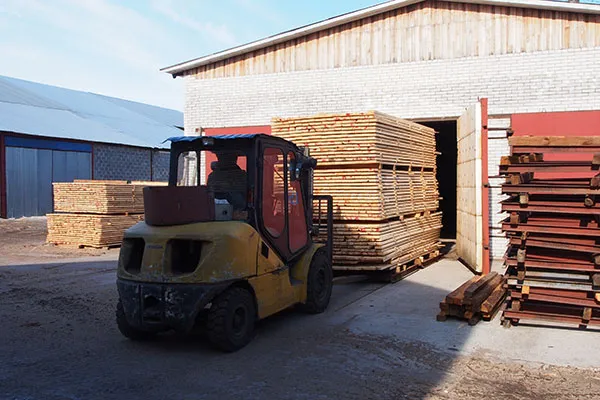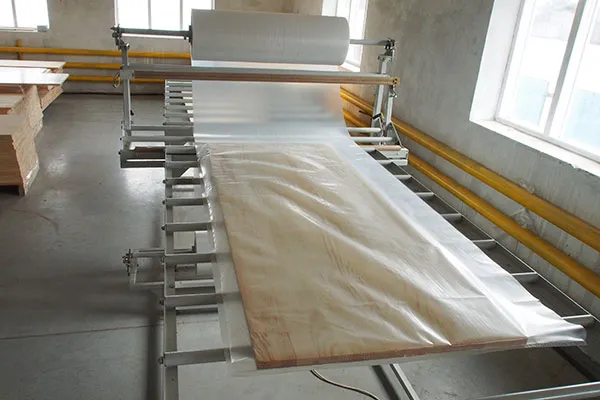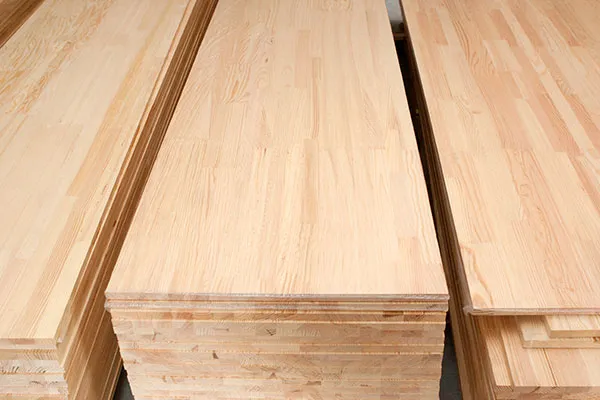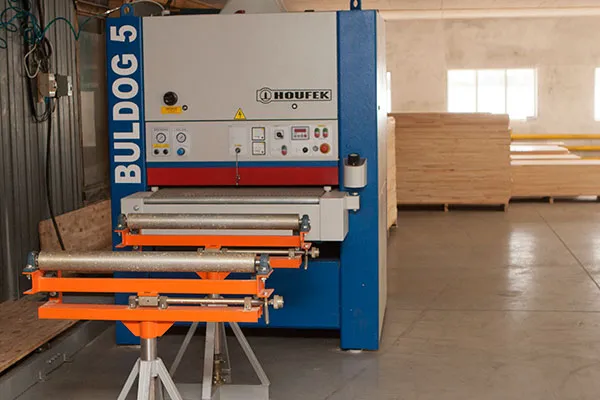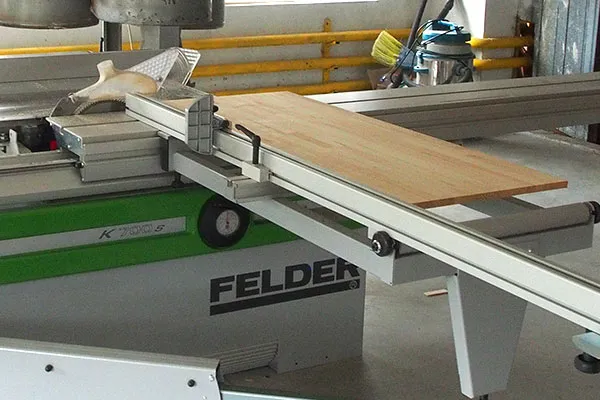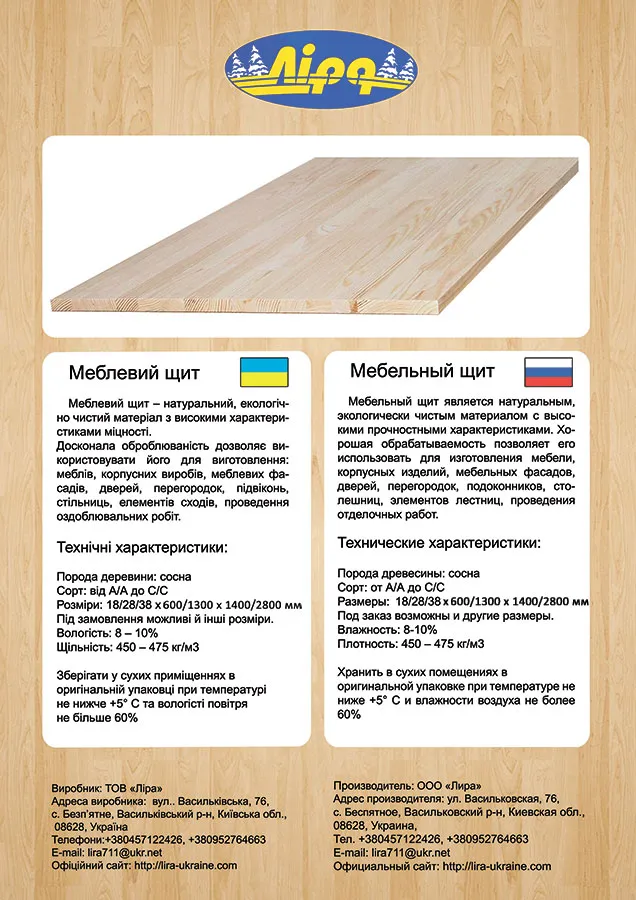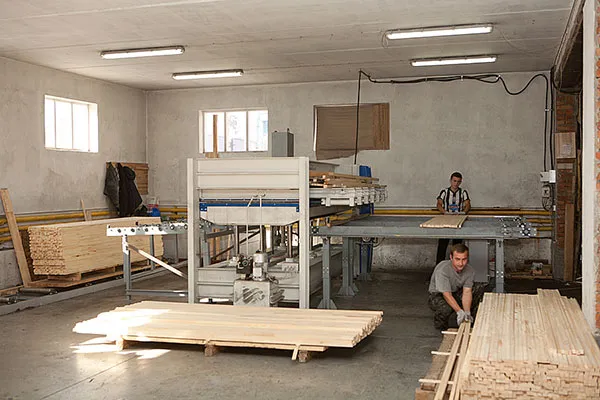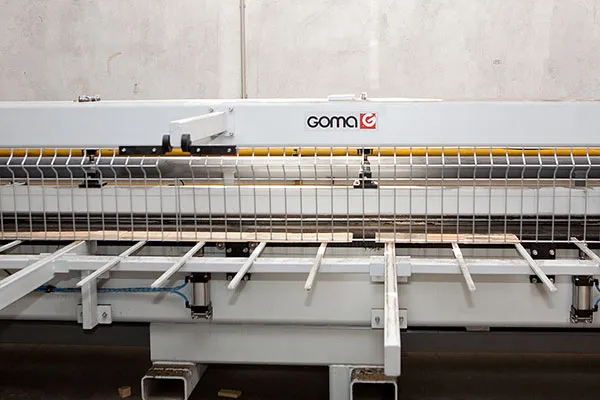
A furniture board is a square or rectangular wood-based sheet material made by gluing together along the width and, in some cases, along the length of planed wooden bars, with a width of each bar from 10 mm to 50 mm. In Ukraine, most of the furniture boards are made of coniferous wood (pine, spruce), and hardwood boards (oak, beech, ash, maple, birch) are also somewhat popular. Furniture panels are used for the manufacture of furniture, decorative elements and building elements, as an environmentally friendly and aesthetically more attractive analogue of chipboard.
The furniture board has been used for a long time and the technology of its manufacture has changed insignificantly over the past 100 years. In the canonical version, wooden bars were pressed together with metal clamps; at present, their functions are performed by presses. A sharp increase in the consumption of furniture panels began in the 70s of the 20th century, when it became possible to mass-produce this product.

- for reasons of environmental safety: furniture board hypoallergenic natural material;
- for reasons of aesthetics: this natural material, when properly processed, looks more refined than substitutes;
- for reasons of practicality.
Advantages of a furniture board over other board materials:
- a) furniture made of wooden panels lasts longer than furniture made of chipboard or MDF;
- b) this furniture is repairable: since the tree is homogeneous in its structure, even a damaged piece of furniture can be restored (not replaced, but restored) and it will look like new;
- c) wood is a hygroscopic material, i.e. it regulates the humidity in the room;
- d) glued board furniture has properties to adsorb harmful substances.
The use of coniferous and deciduous species makes it possible to produce furniture boards of various types and designs with individual textures and various properties. The glued board is divided into quality grades from A to C. The grade is determined by two sides: A/A, A/B, A/C, B/B, B/C, C/C
- grade A is selected according to the pattern, even in tone, uniform in texture, without defects (knots, sapwood, etc.);
- grade B – without pattern selection, even in tone, uniform in texture, without defects;
- Grade C – without selection by pattern, tone and texture, minor defects (knots no more than 5 mm, sapwood). Mechanical damage is not allowed in all classes.
By production of a furniture board it is possible to receive various board depending on a field of its application. There are basically two types here. This is a single-layer glued board, which is also called a massive board, a glued board, or simply a single-layer board. A single-layer shield has a thickness of 14 to 60 mm, made of wooden blanks (slats, boards or timber) with a width of 18 mm, which are glued to each other in one layer parallel to the direction of the fibers.
The second type of glued board is a multi-layered board, consisting of two front layers and a desired but odd number of middle layers. The layers must be laid symmetrically in thickness, which determines the positive properties of the multilayer shield. Multi-layer glued board, usually with a thickness of 12 mm to 60 mm (special size up to 75 mm), three- or five-layer, with symmetrical laying and glued from several single-layer boards representing the front and middle layers.
The main stages of the technological process of manufacturing a furniture board are:
- 1) drying of blanks;
- 2) transverse cutting;
- 3) cutting and cutting;
- 4) preliminary planing;
- 5) trimming and sorting;
- 6) splicing;
- 7) planing;
- 8) gluing;
- 9) formatting;
- 10) grinding;
- 11) packing
Drying blanks
Drying blanks is the main stage of the technological process for the production of furniture panels. It determines the further adaptation of shield materials to the place of their use. Drying of the material takes place in three stages. The first is the preliminary drying of wood in the open air, in a natural way. The drying time of the blanks depends on the climatic conditions (temperature, air humidity and air movement). Depending on the time of year, there may be fluctuations in climatic factors affecting the duration of drying. On average, wood loses 3-5% of its moisture, and these values vary depending on the type of wood. The second stage is the drying of lumber in a drying chamber under the influence of high temperatures over 100 °C. The most common is the method of convective-chamber drying, i.e. in room, equipped with electric or steam heating batteries with mandatory temperature control and humidity measurement inside the drying chamber. Along the access roads, a stack is placed inside the dryer with obligatory gaskets between the layers of the stack. Also, an important point of the drying chamber is the adjustment of the air flows inside, so that the air supersaturated with moisture is constantly drawn out of the chamber. The third stage is the uniform cooling of the wood after evaporation. After the immediate drying process is completed, the wood dries up in places, other areas, on the contrary, are too wet; it is necessary to plan a conditioning phase, during which the unevenly distributed residual moisture in the wood is distributed over the cross section of the workpiece. This increases the relative humidity of the air, while the temperature in the drying chamber does not change. In addition, stresses in the wood decrease; after conditioning, the dried material must be cooled to a temperature of 30-40 ° C; before the chamber opens, the heating is turned off, but the climate is still maintained. You need to know that after drying and in the future, the percentage of moisture in wood for the manufacture of furniture panels should be 9-11%. Loading blanks into the drying chamber
Cross cutting
Cross cutting, or preliminary trimming, trimming of curvature – this stage of the technological process is decisive for the yield and creation of the cost of raw materials. Here the profit per shield is determined. Cross cut, cut to length and trimming are considered together based on maximum yield and value creation. Thus, for each new board, a sequence of optimizing steps is calculated. Mostly dried and warped wood is subjected to transverse cutting. Lumber after drying often has curvature, twisting, which are difficult to optimize to obtain a greater yield of wood. In order to minimize deformation, the so-called trimming is carried out, which reduces the loss of material during the subsequent processing of the workpieces.
The length of the trimmed sections is chosen in such a way that it is possible to obtain a fixed-length lamella through them and that it is easy to handle. In this case, only large defects are cut out of the workpiece and cutting is performed along the ends. In the further technological process, cut boards or lamellas have a rectilinear arrangement of fibers directed parallel to the cut edge.
Trimming and cutting
Trimming involves the removal of rounded parts of the board (wane) from the board or timber. There are different types of pruning. One of them is parallel cropping. The workpiece is cut in one working pass in such a way that the sides and edges are parallel to each other. In this case, at least one of the two processing units must be adjusted, otherwise the material is not optimized in width. When cutting narrow blanks from edged lumber parallel to the edge, the resulting blanks have a direct arrangement of fibers.
Cutting is the cutting of a wide workpiece (we are talking about lumber) in the longitudinal direction into narrow workpieces. In most cases, the core is cut from the blanks, which is located directly in the center of the log and surrounds the core tube. Thanks to cutting lumber, especially very wide blanks, most of the internal stresses are removed. Thus, an improvement in quality is achieved, the boards crack and warp less. For this technological operation, depending on the size and productivity of the company, both technically simple and very complex machines are used. Simple installations include longitudinal edger circular saws, which, with the help of a processing unit, cut round lumber, separating useful material and slats from wide workpieces.
Preplaning
During preliminary planing, a certain layer is removed from the workpiece that has left the sawmill, which allows visual inspection of the surface. Four-sided preliminary planing is carried out after cutting. It is necessary if all sides are controlled, for example by a scanner, and high requirements are placed on the surface of the material. Beneath the contaminated surface that has come out of the sawmill, it is difficult to determine with the naked eye the defects of the wood, discoloration and the direction of the fibers. For the scanner that is used in the next step with optimizing trimming, defect recognition can be difficult due to the poor contrast of the wood.
Trimming and sorting
Trimming or trimming is called cutting blanks to certain lengths. In the production of furniture panels, it is mainly an optimization process that takes into account quality characteristics and thus determines the length of the blanks. The so-called defects of the wood, such as fallen knots, blue stain, pitching, etc., are cut out, as a result, segments free of defects are obtained. Short segments are further connected into blanks of the required length, for example, by splicing on a mini-tenon. The next option is cutting to fixed lengths. In this case, a long board is cut to the required lengths without much consideration for major defects. Some types of wood may not contain defects for several meters. So you can get fixed lengths that do not contain defects. Such blanks are subsequently sorted mainly by length and color. In the production of furniture panels, trimming and sorting are optimizing operations that can be carried out manually or fully automatically.
When processing manually, the recognition of defects is carried out by the worker, who marks the defective place with a fluorescent chalk or laser. The machine reads the marking and makes a cut on this section of the board. The trimmed workpiece is then fed to a sorting station, where it is sorted according to certain criteria.
With full automation of the crosscutting process, the scanner scans up to four sides of the passing workpiece, captures the material data and transfers it to the crosscutting machine. A cut is made and the workpiece is transported further. At the end of the machine there are sorting sections, which, depending on the sorting criteria, have different lengths. Here, the workpieces are automatically distributed by means of ejectors according to certain criteria. Most of the trimmed sections are optimized and sorted here according to color and/or length.
Workpiece optimization on a PAUL machine. Left sorted blanks
Splice
Short trimmed blanks with a length of 150-300 mm should not be sorted into waste, they should be fed further into production. For example, to obtain blanks of various lengths that do not contain defects. Butt joints along the length do not have the strength required for stretching and bending. These loads can be taken without any problems with tenon joints;
Splicing on a vertical spike. The vertical spike is cut into vertically arranged lamellas. The jagged profile is visible on the surface of the shield. It finds application mainly in the production of window, construction and structural timber. A package of blanks is subjected to gear profile milling. In some countries and in some industries, a visible vertical spike on the surface of the shield is accepted. You can find this type of connection on products where it is invisible.
Splicing on a horizontal spike. By production of a furniture board, as a rule, connection on a horizontal tenon is applied. A stepped joint is visible on the surface of the shield. A serrated profile is visible on the narrow side. The lamellae are fed horizontally into a continuously running splicing line. Feeding in the longitudinal direction of pressed short blanks spliced onto a mini-thorn is carried out mainly arbitrarily, the location of annual rings is not taken into account.
Planing
Longitudinal milling in order to remove glue sagging, steps between lamellas, and obtain accurate geometric parameters is called planing.
Rectangularity of the lamellas. The individual lamellas must be rectangular, with an angle exactly equal to 90°. The thicker the workpiece, the more critical the squareness. The adhesive line must not be open, otherwise the board will take on a curved or wavy shape after the press, or the adhesive lines will remain open.
Lamella parallelism. When gluing the lamellas into a board, very small inaccuracies in the width of the individual lamellas can add up and lead to the opening of the adhesive seams. At the same time, soft rock blanks in the press stick together better than hard rock blanks. Accuracy is important.
For optimal bonding of planed lamellas into a solid board, the following conditions must be met:
- the optimal cutting step is 1.5-2.0 mm (if less than 1.5 mm, there is a danger of a polishing effect; more than 2.0 mm – the consumption of glue increases, a visible glue line appears, the cohesive strength of the glue weakens);
- the depth of the pile should be less than 0.1 mm (if more, then the consumption of glue increases, a visible glue line appears, the cohesive strength of the glue weakens).
Gluing
At this stage of the direct production of furniture panels, glue is applied to the narrow side of the finished processed lamellas, and then the lamellas are connected into a shield. Glue is applied to one side of the lamellas. Loading into the press is carried out in a batch way. The lamellae are in contact with each other and are generally pushed mechanically into the pressing area. The press is closed, and the side clamp is activated, leveling the irregularities, at the same time the necessary pressure is applied to the adhesive seams.
Each type of wood must have its own pressing temperature. Recommended blanks should be pressed at low temperatures. Very hot pressing can produce steam. There is a risk of discoloration of the workpieces (steam effect) and the occurrence of cracks in the wood. This applies in particular to recommended wood species such as oak. With prolonged pressing at a temperature of more than 100 ° C, the final drying and shrinkage of the wood occurs. A color change may occur, for example in beech, as a result of the greenhouse effect. A slight temperature difference between the top and bottom hotplates can cause the shield to warp. A temperature difference of 5°C causes the shield to warp. The higher the pressing temperature, the greater the risk of deformation. For the production of oak panels, cold pressing or pressing with high frequency currents is particularly suitable. Oak lamellas, however, at a maximum temperature of 50-60°C are pressed into a high-quality single-layer board. The reason is the short pressing time. At high temperatures, the formation of microcracks is possible, which become visible after varnishing the shield. The surface of the shield dries very quickly, the shield has a tendency to partial long-term warping. Pressing with the use of currents is highly recommended in the production of a massive shield. which become visible after varnishing the shield. The surface of the shield dries very quickly, the shield has a tendency to partial long-term warping. Pressing with the use of currents is highly recommended in the production of a massive shield. which become visible after varnishing the shield. The surface of the shield dries very quickly, the shield has a tendency to partial long-term warping. Pressing with the use of currents is highly recommended in the production of a massive shield.
In the hot method, heat is applied during the pressing process. By applying heat, the pressing time can be greatly reduced. Depending on the required pressing temperature, warm water, hot water, thermal oil are used as a heat carrier. The pressing time is highly dependent on the warm-up time. The larger it is, the longer the pressing process. When using hot water in pipes, the average temperature is 55°C. Hot water heats the wood up to 90-110 °C. Thermal oil in pipes can reach temperatures of 110-130°C
It should be borne in mind that not every heat transfer medium is suitable for every type of wood and every type of glue. PVA glue has thermoplastic properties. When pressed with hot water, the adhesive remains plastic and does not cure. It can only glue at a maximum press temperature of 50-60°C. The pressing time is reduced from 10-30 min. an average of four minutes. Time saving is up to 86%. The urea-based adhesive only cures at high temperatures. A temperature of 60°C or more is required. Warm water temperature is not enough. When using this adhesive, hot water, thermal oil or high frequency currents must be used as a heat transfer medium. The gluing method using high-frequency currents is based on capacitive or dielectric heating in a high-frequency field of alternating voltage. High frequency in the industry is limited to the frequency range of 3-13.56 MHz to avoid faults and superposition of fluctuations – for example, transmitting frequencies from television, radio and military transmissions. Other frequencies require special permission. High frequency currents do not heat the wood. Current seeks the path of least resistance. Since the adhesive has a high moisture content, it heats up more and faster than the surrounding wood (selective heating). In an alternating field, the electrons begin to oscillate, produce friction against each other and thus heat up the adhesive line. Water “boils away”. At the end of the pressing process, the seam is completely cured, during the conventional gluing process, a certain time is required for curing. to avoid faults and superposition of oscillations – for example, transmitting frequencies from television, radio and military transmissions. Other frequencies require special permission. High frequency currents do not heat the wood. Current seeks the path of least resistance. Since the adhesive has a high moisture content, it heats up more and faster than the surrounding wood (selective heating). In an alternating field, the electrons begin to oscillate, produce friction against each other and thus heat up the adhesive line. Water “boils away”. At the end of the pressing process, the seam is completely cured, during the conventional gluing process, a certain time is required for curing. to avoid faults and superposition of oscillations – for example, transmitting frequencies from television, radio and military transmissions. Other frequencies require special permission. High frequency currents do not heat the wood. Current seeks the path of least resistance. Since the adhesive has a high moisture content, it heats up more and faster than the surrounding wood (selective heating). In an alternating field, the electrons begin to oscillate, produce friction against each other and thus heat up the adhesive line. Water “boils away”. At the end of the pressing process, the seam is completely cured, during the conventional gluing process, a certain time is required for curing. Current seeks the path of least resistance. Since the adhesive has a high moisture content, it heats up more and faster than the surrounding wood (selective heating). In an alternating field, the electrons begin to oscillate, produce friction against each other and thus heat up the adhesive line. Water “boils away”. At the end of the pressing process, the seam is completely cured, during the conventional gluing process, a certain time is required for curing. Current seeks the path of least resistance. Since the adhesive has a high moisture content, it heats up more and faster than the surrounding wood (selective heating). In an alternating field, the electrons begin to oscillate, produce friction against each other and thus heat up the adhesive line. Water “boils away”. At the end of the pressing process, the seam is completely cured, during the conventional gluing process, a certain time is required for curing.
Formatting
Formatting is called cutting the shield into a final size (length x width). In industrial formatting, various machines can be used. As a rule, a double trimming machine is used in the production of furniture panels.
The longitudinal side when exiting the press is straight and parallel. In the longitudinal direction, the board has an indefinite shift of the lamellas, which makes it impossible to accurately lay on the existing stops. Therefore, the shield is first cut to length. When cutting to length, the end shift of the lamellas is removed and the base surface for cutting to width is reached. After the shield is cut to length, the width is formatted. The result is a rectangular panel with parallel edges, corresponding to the required dimensions.
Sanding
Calibrating the shield with the removal of adhesive residue, achieving the required thickness dimension and grinding the surface of the shield to obtain the specified purity is called grinding. After formatting the shield, it is transferred to the surface finish by grinding. In this case, the difference in the lamellas is removed. The more precisely the press works, the less material needs to be removed. The service life of the sanding belt is increased and costs are reduced.
When sanding with a wide belt sander, the first sanding step is to make a reference plane. First, the so-called contact roller leveling is carried out. The next step is calibration, in which the material is removed to a certain thickness. Finishing is carried out with a sanding shoe, mainly with a grit of 100, but here the wishes of the customers are taken into account.
Package
After grinding, the glued board is wrapped in a heat-shrinkable polyethylene film in order to protect it from dirt and mechanical stress.
